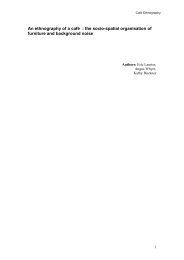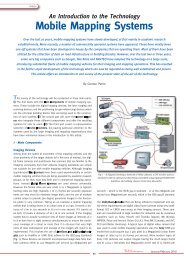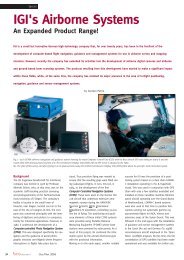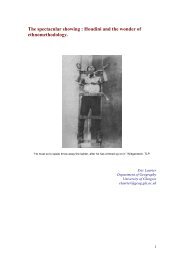MERIS atmospheric water vapor correction model for Wide Swath ...
MERIS atmospheric water vapor correction model for Wide Swath ...
MERIS atmospheric water vapor correction model for Wide Swath ...
Create successful ePaper yourself
Turn your PDF publications into a flip-book with our unique Google optimized e-Paper software.
GRSL-00404-2011 <<br />
IV. DISCUSSION AND CONCLUSIONS<br />
This paper has demonstrated a <strong>MERIS</strong> <strong>water</strong> <strong>vapor</strong><br />
<strong>correction</strong> <strong>model</strong> <strong>for</strong> WS InSAR <strong>for</strong> the first time. This<br />
<strong>correction</strong> <strong>model</strong> has been successfully incorporated into the<br />
commercial SARscape package, and its application to ASAR<br />
WS data suggests that the uncertainty in WS interferograms<br />
can be decreased from 3.8 cm be<strong>for</strong>e <strong>correction</strong> to 0.4 cm after<br />
<strong>correction</strong>.<br />
There are two limitations of the <strong>MERIS</strong> <strong>water</strong> <strong>vapor</strong><br />
<strong>correction</strong> <strong>model</strong>: (i) The <strong>MERIS</strong> <strong>correction</strong> <strong>model</strong> is only<br />
applicable under cloud-free conditions, since <strong>MERIS</strong> near-IR<br />
<strong>water</strong> <strong>vapor</strong> products are sensitive to the presence of clouds. It<br />
should be noted that the Middle-East, North Africa, South<br />
Africa, Australia, Chile, Antarctica, Southern Cali<strong>for</strong>nia and<br />
North Mexico still show cloud-free frequencies as high as<br />
60% or even more [4]. (ii) The <strong>MERIS</strong> <strong>correction</strong> <strong>model</strong> only<br />
works <strong>for</strong> ASAR sub-swaths 1, 2, 3 and 4, as sub-swath 5 does<br />
not fall within the <strong>MERIS</strong> coverage (Fig. 1).<br />
An online system called OSCAR (Online Services <strong>for</strong><br />
Correcting Atmosphere in Radar) is being developed at the Jet<br />
Propulsion Laboratory to provide estimates of the <strong>atmospheric</strong><br />
path delays <strong>for</strong> SAR images and InSAR pairs. OSCAR uses a<br />
variety of different data sources to estimate tropospheric <strong>water</strong><br />
<strong>vapor</strong> at high spatial resolutions <strong>for</strong> any chosen SAR image<br />
date and time. Current data sources include <strong>water</strong> <strong>vapor</strong><br />
measurements from the NASA MODerate-resolution Imaging<br />
Spectrometer (MODIS) and the European Centre <strong>for</strong> Mediumrange<br />
Weather Forecasting (ECMWF), and advanced<br />
interpolation techniques have been developed to make<br />
estimates where MODIS observations are not available [15].<br />
Water <strong>vapor</strong> measurements from <strong>MERIS</strong>, AIRS (the NASA<br />
Atmospheric InfraRed Sounder) and GPS in certain areas with<br />
high-density networks will be employed to correct <strong>for</strong> the<br />
<strong>atmospheric</strong> effects of InSAR observations in the OSCAR<br />
system in the near future. Our recent validation study showed<br />
that the OSCAR-derived <strong>water</strong> <strong>vapor</strong> estimates agreed well<br />
with GPS <strong>water</strong> <strong>vapor</strong> products, with a correlation coefficient<br />
of 0.96 and a standard deviation of 2 mm [16], suggesting that<br />
OSCAR-based <strong>water</strong> <strong>vapor</strong> <strong>correction</strong>s show promise <strong>for</strong><br />
improving WS InSAR measurements.<br />
ACKNOWLEDGMENT<br />
All ENVISAT SAR and <strong>MERIS</strong> data are copyrighted by the<br />
European Space Agency and were provided under project AO-<br />
6440. We are grateful to Juan M. Lopez-Sanchez and an<br />
anonymous reviewer <strong>for</strong> constructive reviews.<br />
REFERENCES<br />
[1] J. Holzner and R. Bamler, "Burst-mode and ScanSAR Interferometry,"<br />
IEEE Trans. Geosci. Remote Sens., vol. 40, pp. 1917-1934, Sept. 2002.<br />
[2] H. A. Zebker, P. A. Rosen, and S. Hensley, “Atmospheric effects in<br />
interferometric synthetic aperture radar surface de<strong>for</strong>mation and<br />
topographic maps”, J. Geophys. Res., vol. 102, pp. 7547-7563, 1997.<br />
[3] T. R. Emardson, F. H. Webb, and P. O. J. Jarlemark, "Analysis of <strong>water</strong><br />
<strong>vapor</strong> spatial variability using GPS, InSAR, microwave radiometer, and<br />
radiosonde data," Jet Propulsion Laboratory, Pasadena, Cali<strong>for</strong>nia 2002.<br />
[4] Z. Li, E. J. Fielding, P. Cross, and R. Preusker, "Advanced InSAR<br />
<strong>atmospheric</strong> <strong>correction</strong>: <strong>MERIS</strong>/MODIS combination and stacked <strong>water</strong><br />
vapour <strong>model</strong>s," Int. J. Remote Sens., vol. 30, pp. 3343-3363, July 2009.<br />
[5] Z. Li, J.-P. Muller, P. Cross, P. Albert, J. Fischer, and R. Bennartz,<br />
"Assessment of the potential of <strong>MERIS</strong> near-infrared <strong>water</strong> vapour<br />
products to correct ASAR interferometric measurements," Int. J. Remote<br />
Sens., vol. 27, pp. 349-365, Jan. 2006.<br />
[6] Z. Li, E. J. Fielding, P. Cross, and J.-P. Muller, "Interferometric<br />
synthetic aperture radar <strong>atmospheric</strong> <strong>correction</strong>: MEdium Resolution<br />
Imaging Spectrometer and Advanced Synthetic Aperture Radar<br />
integration," Geophys. Res. Lett., vol. 33, pp. L06816, Mar. 2006.<br />
[7] B. Puysségur, R. Michel, and J. Avouac, "Tropospheric phase delay in<br />
interferometric synthetic aperture radar estimated from meteorological<br />
<strong>model</strong> and multispectral imagery," J. Geophys. Res., vol. 112, pp.<br />
B05419, May 2007.<br />
[8] W. Xu, Z. Li, X. Ding, G. Feng, J. Hu, J. Long, H. Yin, and Y. Yang,<br />
"Correcting <strong>atmospheric</strong> effects in ASAR interferogram with <strong>MERIS</strong><br />
integrated <strong>water</strong> <strong>vapor</strong> data," Chin. J. Geophys. (in Chinese), vol. 53, pp.<br />
1073-1084, May 2010.<br />
[9] <strong>MERIS</strong> Product Handbook. Issue 2.1, ESA. Available from:<br />
http://envisat.esa.int/pub/ESA_DOC/ENVISAT/<strong>MERIS</strong>/meris.ProductH<br />
andbook.2_1.pdf<br />
[10] R. Bennartz and J. Fischer, "Retrieval of columnar <strong>water</strong> vapour over<br />
land from back-scattered solar radiation using the Medium Resolution<br />
Imaging Spectrometer (<strong>MERIS</strong>)," Remote Sens.Environ., vol. 78, pp.<br />
271-280, Dec. 2001.<br />
[11] P. Albert, R. Bennartz, and J. Fischer, "Remote Sensing of Atmospheric<br />
Water Vapor from Backscattered Sunlight in Cloudy Atmospheres," J<br />
Atmos.Oceanic Technol., vol. 18, pp. 865-874, June 2001.<br />
[12] SARscape. Sarmap. Available from<br />
http://www.sarmap.ch/pdf/SARscapeTechnical.pdf.<br />
[13] T. G. Farr, P. A. Rosen, E. Caro, R. Crippen, R. Duren, S. Hensley, M.<br />
Kobrick, M. Paller, E. Rodriguez, L. Roth, D. Seal, S. Shaffer, J.<br />
Shimada, J. Umland, M. Werner, M. Oskin, D. Burbank and D. Alsdorf,<br />
"The Shuttle Radar Topography Mission," Rev. Geophys, vol. 45, pp.<br />
RG2004, May 2007.<br />
[14] G. J. Funning, B. Parsons, T. J. Wright, J. A. Jackson, and E. J. Fielding,<br />
"Surface displacements and source parameters of the 2003 Bam (Iran)<br />
earthquake from Envisat advanced synthetic aperture radar imagery," J.<br />
Geophys. Res., vol. 110, pp. B09406, Sept. 2005.<br />
[15] P. von Allmen, E. Fielding, E. Fishbein, Z. Xing, L. Pan, M. Lo, and Z.<br />
Li, “OSCAR: Online Services <strong>for</strong> Correction of Atmosphere in Radar”<br />
in 2011 Earth Science Technology Gorum (ESTF2011), Pasadena, CA,<br />
2011, pp 1-5.<br />
[16] P. von Allmen, Z. Xing, E. Fielding, E. Fishbein, L. Pan, and Z. Li,<br />
"OSCAR: Online Service <strong>for</strong> Correcting Atmosphere in Radar," in AGU<br />
Fall Meeting, San Francisco, CA, 2010.<br />
4
















